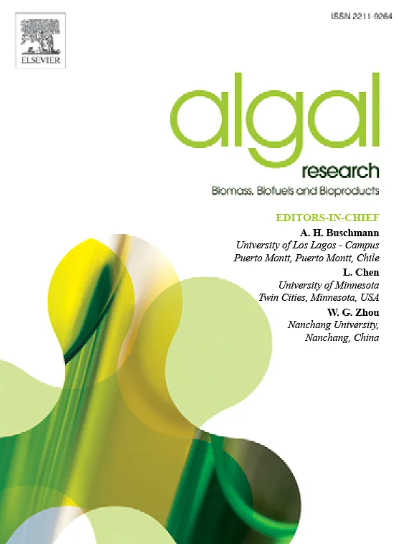生产安全再生水和生物肥料的本土微藻联合体。用于复制、扩大规模和立法分析的批量试验
IF 4.6
2区 生物学
Q1 BIOTECHNOLOGY & APPLIED MICROBIOLOGY
Algal Research-Biomass Biofuels and Bioproducts
Pub Date : 2025-04-16
DOI:10.1016/j.algal.2025.104043
引用次数: 0
摘要
本研究旨在评估利用本地微藻处理污水和生产安全再生水和生物肥料的潜力。采用单一或混合污水流进行培养试验,结合一次污水(PSE)、二次污水(SSE)和浓缩污水(CEN),以确定最合适的基质。总体而言,与SSE相比,PSE中培养的微藻的氮去除率、生物量生产力和碳生物固定率更高,分别为2.1 ~ 12.1 mgN·L−1·d−1、18 ~ 52 mgVSS·L−1·d−1 (20 ~ 53 mgTSS·L−1·d−1)和10.7 ~ 27.0 mgCO2·L−1·d−1。添加浓缩物通过增加营养物质和无机碳的利用率来改善微藻的生产性能,但当添加30%浓缩物时,则出现了不利影响。微藻处理工艺的成本在0.081 ~ 0.098€·m - 3之间,显著低于传统活性污泥(CAS)工艺。在测试期间获得的再生水在病原体和金属水平方面显示出高质量,使其适合(在西班牙)用于农业、娱乐、工业和环境用途。然而,在利用再生水和微藻生物质生产生物肥料方面,发现了一些法律空白。本文章由计算机程序翻译,如有差异,请以英文原文为准。

Indigenous microalgae consortium for producing safe reclaimed water and bio-fertilisers. Batch tests for replication, scale-up and legislative analysis
This study aimed to assess the potential of using indigenous microalgae to treat sewage and produce safe reclaimed water and bio-fertilisers. Cultivation tests were conducted using sole or mixed sewage streams combining primary effluent (PSE), secondary effluent (SSE), and centrate (CEN) to identify the most suitable substrate. Overall, higher nitrogen removal rates, biomass productivity, and carbon biofixation were observed when microalgae were cultivated in PSE compared to SSE, with values ranging from 2.1 to 12.1 mgN·L−1·d−1, 18 to 52 mgVSS·L−1·d−1 (20–53 mgTSS·L−1·d−1), and 10.7 to 27.0 mgCO2·L−1·d−1, respectively. Adding centrate improved microalgae performance by increasing the availability of nutrients and inorganic carbon, but when 30 % centrate was added, detrimental effects were observed. The costs of the microalgae-based treatment process ranged from 0.081 to 0.098 €·m−3, which is significantly lower than those of conventional activated sludge (CAS) processes. The reclaimed water obtained during the tests demonstrated high-quality in terms of pathogen and metal levels, making it suitable (in Spain) for agricultural, recreational, industrial and environmental uses. However, some legal gaps were identified regarding the use of reclaimed water and microalgae biomass for bio-fertiliser production.
求助全文
通过发布文献求助,成功后即可免费获取论文全文。
去求助
来源期刊

Algal Research-Biomass Biofuels and Bioproducts
BIOTECHNOLOGY & APPLIED MICROBIOLOGY-
CiteScore
9.40
自引率
7.80%
发文量
332
期刊介绍:
Algal Research is an international phycology journal covering all areas of emerging technologies in algae biology, biomass production, cultivation, harvesting, extraction, bioproducts, biorefinery, engineering, and econometrics. Algae is defined to include cyanobacteria, microalgae, and protists and symbionts of interest in biotechnology. The journal publishes original research and reviews for the following scope: algal biology, including but not exclusive to: phylogeny, biodiversity, molecular traits, metabolic regulation, and genetic engineering, algal cultivation, e.g. phototrophic systems, heterotrophic systems, and mixotrophic systems, algal harvesting and extraction systems, biotechnology to convert algal biomass and components into biofuels and bioproducts, e.g., nutraceuticals, pharmaceuticals, animal feed, plastics, etc. algal products and their economic assessment
 求助内容:
求助内容: 应助结果提醒方式:
应助结果提醒方式:


